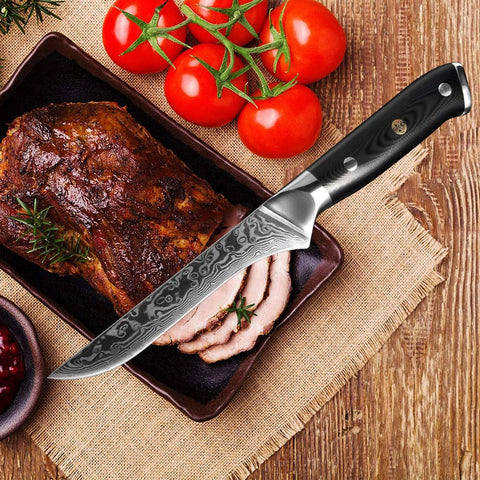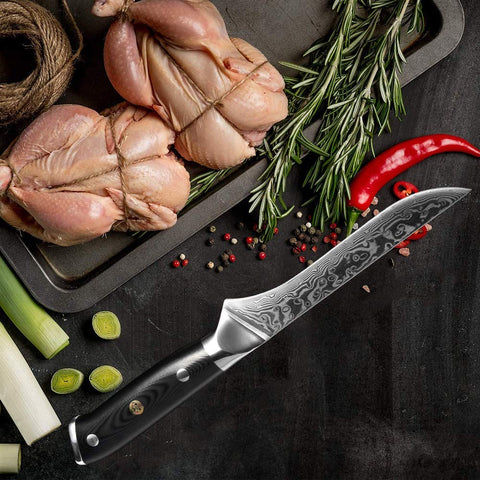The multi-functional boning knife is a game-changer in the kitchen, allowing you to effortlessly separate meat from bones with precision and speed. This not only simplifies the cooking process but also adds an element of enjoyment as you create beautifully prepared dishes.
In this comprehensive guide, we’ll explore the essential qualities of a great boning knife, the various types available, and how to select the perfect one for your culinary needs. Additionally, we’ll highlight some remarkable options from SAKUTO Knives, renowned for their superior craftsmanship and elegant designs.

### What Makes a Boning Knife Exceptional?
A top-notch boning knife is defined by three critical factors: sharpness, flexibility, and ergonomic design. Let’s break down what each entails:
- **Blade Material & Sharpness**: A high-quality boning knife requires a blade made from premium steel that retains its edge over time. Japanese Damascus steel stands out due to its durability and razor-sharp edge.
- **Flexibility**: Depending on the task, you may need either a flexible or a stiff blade. Flexible blades excel at delicate tasks like filleting fish, while stiffer blades are ideal for tougher jobs such as deboning chicken or pork.
- **Handle Comfort & Grip**: For accuracy and safety, the handle should fit comfortably in your hand. Ergonomic designs ensure a secure grip, reducing fatigue during prolonged use.
### Choosing the Right Boning Knife
Selecting the appropriate boning knife depends largely on the type of food you’re preparing. When working with fish, opt for a flexible boning knife for smoother cuts. For red meat or poultry, a stiffer blade provides the precision needed for efficient bone removal.

#### Cutting Techniques
To achieve clean, efficient cuts, hold the knife at a slight angle and apply smooth, even strokes along the bone. This technique minimizes waste and ensures a neat separation.
#### Maintenance and Sharpening
Proper care is crucial for maintaining your boning knife’s performance. Regular honing keeps the blade sharp, while sharpening should be done sparingly to preserve its edge and reduce the risk of accidents.
### Types of Boning Knives
There are two primary types of boning knives: flexible and stiff. Flexible knives are versatile and ideal for intricate tasks, while stiff knives handle tougher cuts with ease. Another consideration is blade shape—curved blades offer greater maneuverability, while straight blades provide enhanced control.
### Real-World Applications
Boning knives find practical use in various culinary scenarios:
- **Filleting Fish**: A flexible boning knife excels at removing flesh from bones with minimal effort.
- **Deboning Poultry**: A stiff boning knife simplifies the process of removing bones from chicken or turkey, ensuring clean cuts.
- **Trimming Meat**: For precise portioning, a boning knife is indispensable for trimming excess fat and sinew.
### Promoting Quality Knives: Elevate Your Cooking Experience
For those seeking premium boning knives, SAKUTO offers exceptional choices:
- **Gyuto Japanese Damascus Steel Knife with Colored Blue Handle**: This knife boasts unparalleled sharpness and a stylish blue handle, making it perfect for detailed cutting tasks.
- **Okugai Damascus Steel Kitchen Knife with Abalone Handle**: Combining aesthetic appeal with functionality, this knife features an abalone handle and a blade crafted from Damascus steel, ensuring sharpness and longevity.
### Frequently Asked Questions (FAQs)
- **Difference Between Boning and Fillet Knives**: Boning knives are robust, designed for separating meat from bones, whereas fillet knives are lightweight and flexible, optimized for fish filleting.
- **How to Sharpen a Boning Knife**: Use a sharpening stone or knife sharpener at a 20-degree angle, drawing the blade evenly across the surface.
- **Using a Boning Knife on Vegetables**: While possible, it’s not recommended as frequent use on hard surfaces can quickly dull the blade.
- **Best Storage Practices**: Store your boning knife in a knife block, on a magnetic strip, or within a protective sheath to maintain its edge and ensure safety.
- **Frequency of Honing and Sharpening**: Honing before each use and sharpening every few months, depending on usage frequency, will keep your knife in peak condition.
With these insights, you’re now equipped to choose and care for a boning knife that meets your culinary needs. Whether you're a seasoned chef or a home cook, investing in a quality boning knife can significantly enhance your cooking experience.
Canned Tuna,Fresh Canned Tuna,Frozen Canned Tuna,Canned Skipjack Chunk
ZHEJIANG RETRONX FOODSTUFF INDUSTRY CO.,LTD , https://www.retronxfoods.com